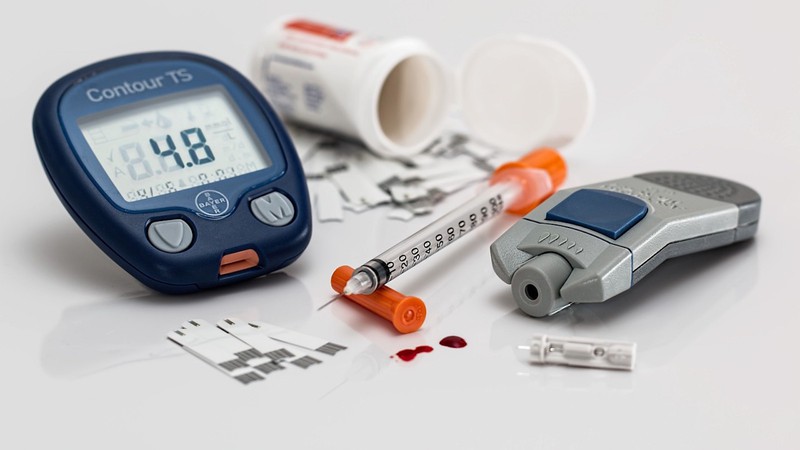Gov. says California is already working on effort to manufacture its own insulin at lower costs.

Gov. Newsom calls bringing down price of insulin “a priority,” then vetoes a bill to do just that. Steve Buissinne / Pixabay Pixabay License
BY , CalMatters
Gov. Gavin Newsom has made lowering the cost of prescription drugs a signature health care issue, but over the weekend, he rejected a bill that would have provided some relief for diabetics by capping what they pay for insulin.
His reasoning: California is already working on a separate effort to manufacture and distribute insulin at a cheaper price.
“Bringing down the costs of prescription drugs, and particularly insulin, has long been a priority of mine. With CalRx, we are getting at the underlying cost, which is the true sustainable solution to high-cost pharmaceuticals.”
GOV. GAVIN NEWSOM
The trouble is, that program has not yet begun producing the medication.
Senate Bill 90 by Sen. Scott Wiener, a San Francisco Democrat, would have prohibited state-regulated health insurance plans from imposing a deductible on insulin prescriptions and would have capped copays at $35 for a 30-day supply. California’s current copay limit for most prescription drugs is $250.
The bill’s opponents, mainly the health insurance industry, argued that the approach would result in higher costs for Californians in the form of higher insurance premiums.
The underlying issue, according to insurers, is the price set by pharmaceutical companies. Currently, what people pay out of pocket is based on their insurance coverage. People without insurance would not benefit from a copay cap and would still be on the hook for the full price. Newsom echoed this reasoning in his veto message.
“Bringing down the costs of prescription drugs, and particularly insulin, has long been a priority of mine,” Newsom said in his veto message. “With CalRx (the state’s prescription drug initiative), we are getting at the underlying cost, which is the true sustainable solution to high-cost pharmaceuticals. With copay caps however, the long-term costs are still passed down to consumers through higher premiums from health plans.”
An independent analysis of the bill by a state health office estimated that spending for consumers would have increased by 0.02 percent because of higher annual insurance premiums. Meanwhile, the average insured beneficiary could have seen their prescription drop 67 percent from $61 to $20.
California’s Insulin Initiative
Via the CalRx Biosimilar Insulin Initiative, Newsom has promised insulin will cost no more than $30 per 10 ml vial or $55 for five 3 ml cartridges, which currently can run up to $300 and $500, respectively. The governor has said that the reduced price will be available to patients across the country, insured and uninsured.
When will California’s more affordable insulin become available? That’s yet to be determined.
In March, the governor announced a $50 million partnership with Civica Rx, a nonprofit created by health systems and philanthropy, that will initially make California’s insulin out of its manufacturing plant in Virginia. The plan is to eventually stand up an insulin manufacturing facility in California.
Civica Rx is set to produce three insulins–glargine, lispro and aspart—generics that are interchangeable with the brands Lantus, Humalog and Novolog.
So when will California’s more affordable insulin become available? That’s yet to be determined.
“At this time, we do not have a specific timeframe for approval by the U.S. Food and Drug Administration,” said Andrew DiLuccia, a spokesperson for the state’s Department of Health Care Access and Information, which is overseeing the insulin project. He noted that developing insulin products requires clinical studies focused on safety, effectiveness and quality.
In an interview published last December in Annals of Internal Medicine, Dr. Mark Ghaly, the state’s health secretary, said the goal is for California to have insulin on the shelves within two to three years.
Among the initiative’s potential challenges: sufficient funding to continue forward. The initiative launched last year when the state had a budget surplus. As California builds up its program, it will need ongoing dollars to sustain it and counter any potential backlash from other insulin makers, according to an analysis published earlier this year in the Journal of the American Medical Association.
Insulin Copay Caps
The American Diabetes Association has pushed for insulin copay caps across the country as a way to get some quick relief to diabetics. At least twenty-five states and the District of Columbia have enacted caps on insulin copays, ranging from $25 to $100 a month.
A national survey found that approximately 16.5 percent of insulin users ration their medication. Rationing insulin leads to poor control of diabetes and is linked to increased instances of strokes, heart failure and kidney failure.
Wiener’s SB 90 would have mirrored the federal government’s $35 cap on insulin prescriptions for people on Medicare, the health program for seniors and people with disabilities.
“The American Diabetes Association is disappointed in the governor’s decision to veto Senate Bill 90, legislation that had broad bipartisan support and which moved through the legislature without a single no vote,” said Lisa Murdock, chief advocacy officer at the association, a sponsor of the bill. Her organization will look for ways to continue working with the governor’s office on this affordability issue, she added.
The diabetes association estimates there are about 3 million diabetics in California.
The burden of insulin costs has a long history—stories about people rationing their medication and relying on the emergency room for their uncontrolled diabetes are common throughout the country.
A national survey from last year found that approximately 16.5 percent of insulin users ration their medication, usually by delaying the purchase of it. Rationing insulin leads to poor control of diabetes and is linked to increased instances of strokes, heart failure and kidney failure.
The article titled “Gavin Newsom is working to lower the cost of insulin. Why did he veto a cap on copays?” appeared first at CalMatters.org.
CalMatters is a nonprofit, nonpartisan media venture explaining California policies and politics.